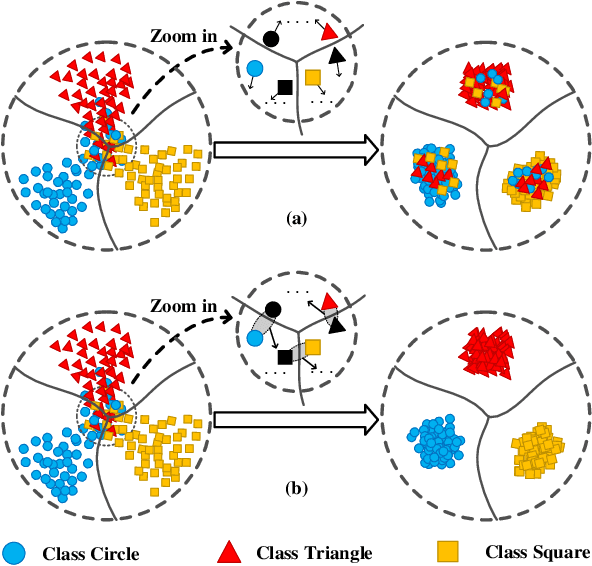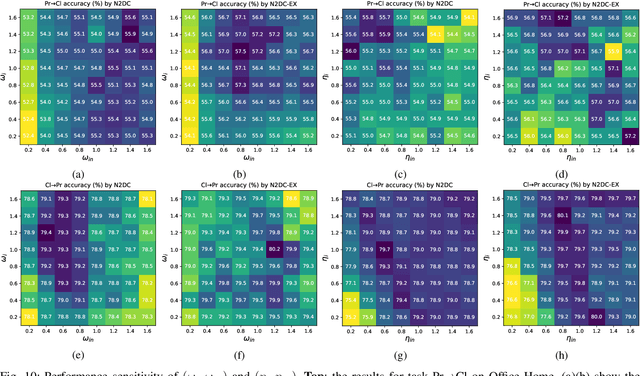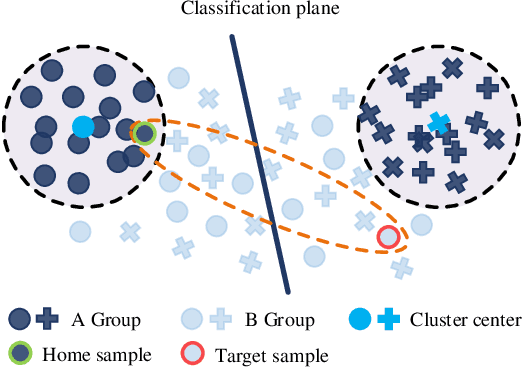Song Tang
Multimodal Referring Segmentation: A Survey
Aug 01, 2025Abstract:Multimodal referring segmentation aims to segment target objects in visual scenes, such as images, videos, and 3D scenes, based on referring expressions in text or audio format. This task plays a crucial role in practical applications requiring accurate object perception based on user instructions. Over the past decade, it has gained significant attention in the multimodal community, driven by advances in convolutional neural networks, transformers, and large language models, all of which have substantially improved multimodal perception capabilities. This paper provides a comprehensive survey of multimodal referring segmentation. We begin by introducing this field's background, including problem definitions and commonly used datasets. Next, we summarize a unified meta architecture for referring segmentation and review representative methods across three primary visual scenes, including images, videos, and 3D scenes. We further discuss Generalized Referring Expression (GREx) methods to address the challenges of real-world complexity, along with related tasks and practical applications. Extensive performance comparisons on standard benchmarks are also provided. We continually track related works at https://github.com/henghuiding/Awesome-Multimodal-Referring-Segmentation.
Is Foreground Prototype Sufficient? Few-Shot Medical Image Segmentation with Background-Fused Prototype
Dec 04, 2024Abstract:Few-shot Semantic Segmentation(FSS)aim to adapt a pre-trained model to new classes with as few as a single labeled training sample per class. The existing prototypical work used in natural image scenarios biasedly focus on capturing foreground's discrimination while employing a simplistic representation for background, grounded on the inherent observation separation between foreground and background. However, this paradigm is not applicable to medical images where the foreground and background share numerous visual features, necessitating a more detailed description for background. In this paper, we present a new pluggable Background-fused prototype(Bro)approach for FSS in medical images. Instead of finding a commonality of background subjects in support image, Bro incorporates this background with two pivot designs. Specifically, Feature Similarity Calibration(FeaC)initially reduces noise in the support image by employing feature cross-attention with the query image. Subsequently, Hierarchical Channel Adversarial Attention(HiCA)merges the background into comprehensive prototypes. We achieve this by a channel groups-based attention mechanism, where an adversarial Mean-Offset structure encourages a coarse-to-fine fusion. Extensive experiments show that previous state-of-the-art methods, when paired with Bro, experience significant performance improvements. This demonstrates a more integrated way to represent backgrounds specifically for medical image.
Domain Adaptive Diabetic Retinopathy Grading with Model Absence and Flowing Data
Dec 02, 2024



Abstract:Domain shift (the difference between source and target domains) poses a significant challenge in clinical applications, e.g., Diabetic Retinopathy (DR) grading. Despite considering certain clinical requirements, like source data privacy, conventional transfer methods are predominantly model-centered and often struggle to prevent model-targeted attacks. In this paper, we address a challenging Online Model-aGnostic Domain Adaptation (OMG-DA) setting, driven by the demands of clinical environments. This setting is characterized by the absence of the model and the flow of target data. To tackle the new challenge, we propose a novel approach, Generative Unadversarial ExampleS (GUES), which enables adaptation from a data-centric perspective. Specifically, we first theoretically reformulate conventional perturbation optimization in a generative way--learning a perturbation generation function with a latent input variable. During model instantiation, we leverage a Variational AutoEncoder to express this function. The encoder with the reparameterization trick predicts the latent input, whilst the decoder is responsible for the generation. Furthermore, the saliency map is selected as pseudo-perturbation labels. Because it not only captures potential lesions but also theoretically provides an upper bound on the function input, enabling the identification of the latent variable. Extensive comparative experiments on DR benchmarks with both frozen pre-trained models and trainable models demonstrate the superiority of GUES, showing robustness even with small batch size.
Rethinking Weak-to-Strong Augmentation in Source-Free Domain Adaptive Object Detection
Oct 07, 2024



Abstract:Source-Free domain adaptive Object Detection (SFOD) aims to transfer a detector (pre-trained on source domain) to new unlabelled target domains. Current SFOD methods typically follow the Mean Teacher framework, where weak-to-strong augmentation provides diverse and sharp contrast for self-supervised learning. However, this augmentation strategy suffers from an inherent problem called crucial semantics loss: Due to random, strong disturbance, strong augmentation is prone to losing typical visual components, hindering cross-domain feature extraction. To address this thus-far ignored limitation, this paper introduces a novel Weak-to-Strong Contrastive Learning (WSCoL) approach. The core idea is to distill semantics lossless knowledge in the weak features (from the weak/teacher branch) to guide the representation learning upon the strong features (from the strong/student branch). To achieve this, we project the original features into a shared space using a mapping network, thereby reducing the bias between the weak and strong features. Meanwhile, a weak features-guided contrastive learning is performed in a weak-to-strong manner alternatively. Specifically, we first conduct an adaptation-aware prototype-guided clustering on the weak features to generate pseudo labels for corresponding strong features matched through proposals. Sequentially, we identify positive-negative samples based on the pseudo labels and perform cross-category contrastive learning on the strong features where an uncertainty estimator encourages adaptive background contrast. Extensive experiments demonstrate that WSCoL yields new state-of-the-art performance, offering a built-in mechanism mitigating crucial semantics loss for traditional Mean Teacher framework. The code and data will be released soon.
Few-Shot Medical Image Segmentation with High-Fidelity Prototypes
Jun 26, 2024



Abstract:Few-shot Semantic Segmentation (FSS) aims to adapt a pretrained model to new classes with as few as a single labelled training sample per class. Despite the prototype based approaches have achieved substantial success, existing models are limited to the imaging scenarios with considerably distinct objects and not highly complex background, e.g., natural images. This makes such models suboptimal for medical imaging with both conditions invalid. To address this problem, we propose a novel Detail Self-refined Prototype Network (DSPNet) to constructing high-fidelity prototypes representing the object foreground and the background more comprehensively. Specifically, to construct global semantics while maintaining the captured detail semantics, we learn the foreground prototypes by modelling the multi-modal structures with clustering and then fusing each in a channel-wise manner. Considering that the background often has no apparent semantic relation in the spatial dimensions, we integrate channel-specific structural information under sparse channel-aware regulation. Extensive experiments on three challenging medical image benchmarks show the superiority of DSPNet over previous state-of-the-art methods.
Proxy Denoising for Source-Free Domain Adaptation
Jun 03, 2024Abstract:Source-free Domain Adaptation (SFDA) aims to adapt a pre-trained source model to an unlabeled target domain with no access to the source data. Inspired by the success of pre-trained large vision-language (ViL) models in many other applications, the latest SFDA methods have also validated the benefit of ViL models by leveraging their predictions as pseudo supervision. However, we observe that ViL's predictions could be noisy and inaccurate at an unknown rate, potentially introducing additional negative effects during adaption. To address this thus-far ignored challenge, in this paper, we introduce a novel Proxy Denoising (ProDe) approach. Specifically, we leverage the ViL model as a proxy to facilitate the adaptation process towards the latent domain-invariant space. Critically, we design a proxy denoising mechanism for correcting ViL's predictions. This is grounded on a novel proxy confidence theory by modeling elegantly the domain adaption effect of the proxy's divergence against the domain-invariant space. To capitalize the corrected proxy, we further derive a mutual knowledge distilling regularization. Extensive experiments show that our ProDe significantly outperforms the current state-of-the-art alternatives under both conventional closed-set setting and the more challenging open-set, partial-set and generalized SFDA settings. The code will release soon.
Unified Source-Free Domain Adaptation
Mar 12, 2024Abstract:In the pursuit of transferring a source model to a target domain without access to the source training data, Source-Free Domain Adaptation (SFDA) has been extensively explored across various scenarios, including closed-set, open-set, partial-set, and generalized settings. Existing methods, focusing on specific scenarios, not only address only a subset of challenges but also necessitate prior knowledge of the target domain, significantly limiting their practical utility and deployability. In light of these considerations, we introduce a more practical yet challenging problem, termed unified SFDA, which comprehensively incorporates all specific scenarios in a unified manner. To tackle this unified SFDA problem, we propose a novel approach called Latent Causal Factors Discovery (LCFD). In contrast to previous alternatives that emphasize learning the statistical description of reality, we formulate LCFD from a causality perspective. The objective is to uncover the causal relationships between latent variables and model decisions, enhancing the reliability and robustness of the learned model against domain shifts. To integrate extensive world knowledge, we leverage a pre-trained vision-language model such as CLIP. This aids in the formation and discovery of latent causal factors in the absence of supervision in the variation of distribution and semantics, coupled with a newly designed information bottleneck with theoretical guarantees. Extensive experiments demonstrate that LCFD can achieve new state-of-the-art results in distinct SFDA settings, as well as source-free out-of-distribution generalization.Our code and data are available at https://github.com/tntek/source-free-domain-adaptation.
Source-Free Domain Adaptation with Frozen Multimodal Foundation Model
Nov 27, 2023



Abstract:Source-Free Domain Adaptation (SFDA) aims to adapt a source model for a target domain, with only access to unlabeled target training data and the source model pre-trained on a supervised source domain. Relying on pseudo labeling and/or auxiliary supervision, conventional methods are inevitably error-prone. To mitigate this limitation, in this work we for the first time explore the potentials of off-the-shelf vision-language (ViL) multimodal models (e.g.,CLIP) with rich whilst heterogeneous knowledge. We find that directly applying the ViL model to the target domain in a zero-shot fashion is unsatisfactory, as it is not specialized for this particular task but largely generic. To make it task specific, we propose a novel Distilling multimodal Foundation model(DIFO)approach. Specifically, DIFO alternates between two steps during adaptation: (i) Customizing the ViL model by maximizing the mutual information with the target model in a prompt learning manner, (ii) Distilling the knowledge of this customized ViL model to the target model. For more fine-grained and reliable distillation, we further introduce two effective regularization terms, namely most-likely category encouragement and predictive consistency. Extensive experiments show that DIFO significantly outperforms the state-of-the-art alternatives. Our source code will be released.
SwinLSTM:Improving Spatiotemporal Prediction Accuracy using Swin Transformer and LSTM
Aug 19, 2023Abstract:Integrating CNNs and RNNs to capture spatiotemporal dependencies is a prevalent strategy for spatiotemporal prediction tasks. However, the property of CNNs to learn local spatial information decreases their efficiency in capturing spatiotemporal dependencies, thereby limiting their prediction accuracy. In this paper, we propose a new recurrent cell, SwinLSTM, which integrates Swin Transformer blocks and the simplified LSTM, an extension that replaces the convolutional structure in ConvLSTM with the self-attention mechanism. Furthermore, we construct a network with SwinLSTM cell as the core for spatiotemporal prediction. Without using unique tricks, SwinLSTM outperforms state-of-the-art methods on Moving MNIST, Human3.6m, TaxiBJ, and KTH datasets. In particular, it exhibits a significant improvement in prediction accuracy compared to ConvLSTM. Our competitive experimental results demonstrate that learning global spatial dependencies is more advantageous for models to capture spatiotemporal dependencies. We hope that SwinLSTM can serve as a solid baseline to promote the advancement of spatiotemporal prediction accuracy. The codes are publicly available at https://github.com/SongTang-x/SwinLSTM.
Nearest Neighborhood-Based Deep Clustering for Source Data-absent Unsupervised Domain Adaptation
Aug 03, 2021



Abstract:In the classic setting of unsupervised domain adaptation (UDA), the labeled source data are available in the training phase. However, in many real-world scenarios, owing to some reasons such as privacy protection and information security, the source data is inaccessible, and only a model trained on the source domain is available. This paper proposes a novel deep clustering method for this challenging task. Aiming at the dynamical clustering at feature-level, we introduce extra constraints hidden in the geometric structure between data to assist the process. Concretely, we propose a geometry-based constraint, named semantic consistency on the nearest neighborhood (SCNNH), and use it to encourage robust clustering. To reach this goal, we construct the nearest neighborhood for every target data and take it as the fundamental clustering unit by building our objective on the geometry. Also, we develop a more SCNNH-compliant structure with an additional semantic credibility constraint, named semantic hyper-nearest neighborhood (SHNNH). After that, we extend our method to this new geometry. Extensive experiments on three challenging UDA datasets indicate that our method achieves state-of-the-art results. The proposed method has significant improvement on all datasets (as we adopt SHNNH, the average accuracy increases by over 3.0% on the large-scaled dataset). Code is available at https://github.com/tntek/N2DCX.
 Add to Chrome
Add to Chrome Add to Firefox
Add to Firefox Add to Edge
Add to Edge